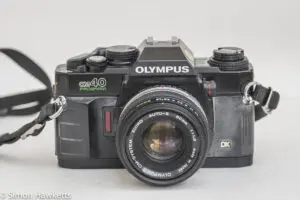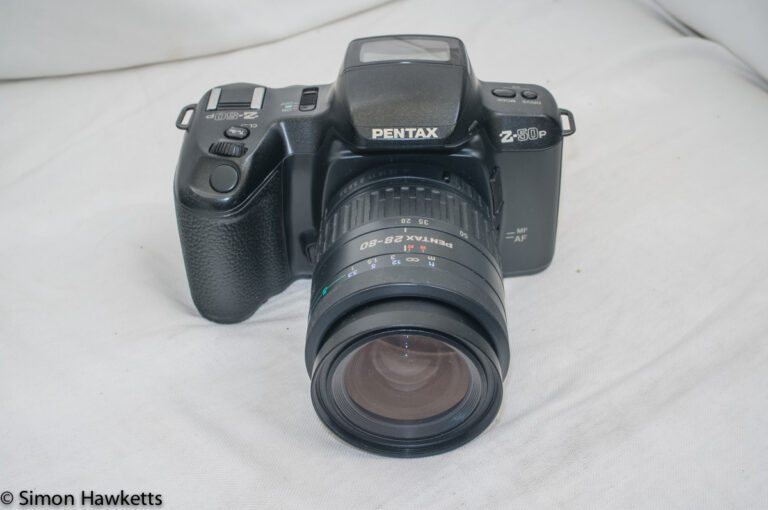Olympus OM-40 35 mm SLR camera
The Olympus OM-40 was the top camera in the Olympus manual focus amateur offering in the early 1980s.
The first in the line was the OM-10, which featured only aperture priority auto exposure (although a manual adapter was made available as an option to plug in and allow shutter speeds to be also set). The next model was the OM-20 which had both manual and aperture priority exposure modes and this was followed by the OM-30 which had a primitive autofocus system. The OM-40 which followed was manual focus only, but offered Program mode, Aperture Priority, Manual mode and switchable matrix metering.
Olympus OM-40 Images







My Olympus OM-40 Camera
I purchased this camera from a charity shop on eBay for £7-50 in unknown condition. I’ve worked on the OM-1 and OM-2 pro series, and also the OM-10 and found them to be pretty easy to get going if they are faulty, so I thought it wouldn’t be much of a gamble to pay such a small amount for what is a very nice camera.
As it happens, when the camera turned up I only needed to fit a new set of batteries and everything sprang to life and the camera seems to work perfectly. Since I didn’t get a lens with the camera (that would probably be asking too much for £7-50), I used the lens from my OM-2 for the purposes of the pictures above.
The only cosmetic problem with the camera is a very slight scratch on the black of the top cover just above the strap connector on the film advance side, and the black padded covering has a slightly milky look, which I think is common with this model. I think it may be possible to blacken it up again with one of the products used to do a similar job on black car trim.
Olympus OM-40 Description
As I said above, the OM-40 is a manual focus, 35 mm SLR with various exposure modes, pattern or ‘off the film’ metering, DX coded automatic film speed selection and an improved viewfinder display. It was the top camera in the manual focus OM-xx series.
The general styling of the camera is a bit different from the other cameras in the double-digit series. The body covering is more padded and there is a noticeable hand grip fitted, a bit like the OM-20 but with a softer feel.
Controls
The basic control layout of the OM-40 top panel is similar to the OM-2, with a mode switch on the left-hand side and a large exposure compensation dial on the right-hand side.
The mode switch has more options available on the OM-40 because as well as the Auto and Manual modes, there is also a P or Program mode. Similarly, the exposure compensation dial has an additional function to it’s OM-2 counterpart because it can set the camera to use the film speed set on the DX code rather than setting it manually. The shutter speed selection is made with a switch fitted around the lens mount and is characteristic of the OM series.
The Exposure compensation dial also doubles as the film speed dial, as on the OM-2, and it is by changing the film speed setting that the exposure compensation is applied. Because of that, when the camera is set to use the DX coding on the film canister, it isn’t possible to apply any compensation. For this reason, I think I would probably always override the DX coding and apply the ISO manually.
Metering
As well as the addition of the Program mode, I guess the other stand out feature of the OM-40 was the inclusion of the additional metering mode called ‘ESP’ (Electro-Selective Pattern) which is selected by a switch at the side of the prism housing.
This is an early form of matrix or pattern metering, where the camera measures light from several regions and tries to determine how to calculate the best exposure. Later cameras have sophisticated schemes with hundreds of different regions, but the OM-40 just measures the middle and the rest of the frame to make that decision. There is also the very accurate Olympus ‘off the film’ measurement, where the camera measures the light reflected from the film surface during the exposure.
Viewfinder
The viewfinder is typical of the OM series; big and bright and with a central split focus aid to help nail the focus. The information in the display is pretty good when in auto or program mode because the shutter speed the camera has selected is shown down the left-hand side.
In manual mode, however, the display just shows what the camera thinks you should use, so you have to transfer this reading to the actual shutter speed dial. This is not a simple operation because the shutter speed dial is hidden from view by the prism overhang, so you need to turn the camera round and view it from the front. I suspect I’ll be shooting in Aperture Priority mode!
Other features
The self-timer switch is fitted to the top of the camera above the film advance and is automatically cancelled when the film advance is operated. This makes sure you have to set it every time you want to use it, which is quite a neat idea.
One thing which is missing is an on/off switch, which is why the camera has a reputation for getting through batteries very quickly. I’m just about to load some film and try out the ESP metering and program mode – If I find the batteries drain quickly, I’ll update this post.
Olympus OM-40 Specifications
- Olympus OM-40 35mm manual focus slr
- Aperture priority, Program mode and manual exposure
- Metering by OTF or ESP
- 1 sec to 1/1000 + B shutter speed
- +/- 2 stops exposure compensation (not with DX film)
- ASA range 25 to 3200
- Powered by two SR44 batteries (easily available)
- Electronic self timer approx 10 sec
- OM bayonet mount lens
- Optional motor drive unit available
- Split rangefinder focusing aid
- LED Shutter speed indication in viewfinder
- Hot shoe sync socket
- Ser No: 1096581
- Manual available here.
Discover more from Everything Vintage
Subscribe to get the latest posts sent to your email.






